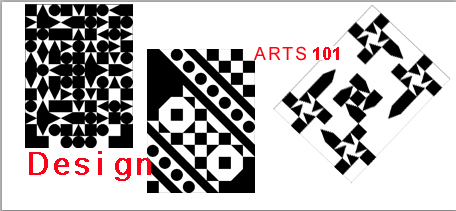 Design
is an introduction to studio art. Its objective is to explore concepts and
develop many of the skills used by artists, designers, and visually educated
people. Design class differs from art history or art appreciation courses
in that participants develop visual acumen (an "eye") or critical visual
judgment through a sequence of studio experiments/experiences wherein
they make as well as analyze "pictures". Elemental principles of two-dimensional
composition starting with surface organization using the plastic elements
of pictorial composition; line, shape, value, space, and color are put
to use by each member of the class. Design
is an introduction to studio art. Its objective is to explore concepts and
develop many of the skills used by artists, designers, and visually educated
people. Design class differs from art history or art appreciation courses
in that participants develop visual acumen (an "eye") or critical visual
judgment through a sequence of studio experiments/experiences wherein
they make as well as analyze "pictures". Elemental principles of two-dimensional
composition starting with surface organization using the plastic elements
of pictorial composition; line, shape, value, space, and color are put
to use by each member of the class.
Assignments are completed in water-based acrylic paints on paper. Instruction in the use of these as well as other materials and tools is ongoing throughout the semester. The initial assignments are in black and white media, and subsequent, more complex compositional assignments are developed in color. A vocabulary of terms useful in describing visual subject matter develops during discussions. At critiques, which take place upon completion of each assignment, works are compared and contrasted. Useful technical information and various significant ideas are highlighted. These discussions are the base of information on which future assignments and their solutions are predicated. The semesters work is divided into two parts. The first part is comprised of five assignments which deal with surface organization. The emphasis is on compositions of non-objective shapes and lines. At first, the compositional elements are regarded as a flat two-dimensional, puzzle-like constructs. As the sequence of assignments builds to its conclusion, implications of three-dimensional illusion are addressed. Each assignment is completed on 18x24 inch drawing paper using acrylic paint. The goal in each of the first five assignments is to achieve a balance between the black and white areas that create the composition. The balance of the semester, part two, is devoted to integrating and
incorporating color, physically and conceptually, into the pictorial
organization. After an introductory lecture on color theory, three exercises
in the form of charts are assigned. They make possible an objective
comparison of important aspects of color: hue, value, intensity, and
temperature. Interesting assignments follow affording an opportunity
for each person to realize his or her own ideas and creative resources.
Each assignment is always concluded with a critique and lively discussion.
 Syllabus |Materials & Tools List
| Home Syllabus |Materials & Tools List
| Home
Office Hours: Tuesday & Thursday, 9:15-10:15 and 12:15-1:15 +by appt. Leave messages in my mailbox at the Art Office, 196 Walsh Telephone: 687-6990 & voice mail or 7-7010, or E-Mail: charlesp@georgetown.edu |